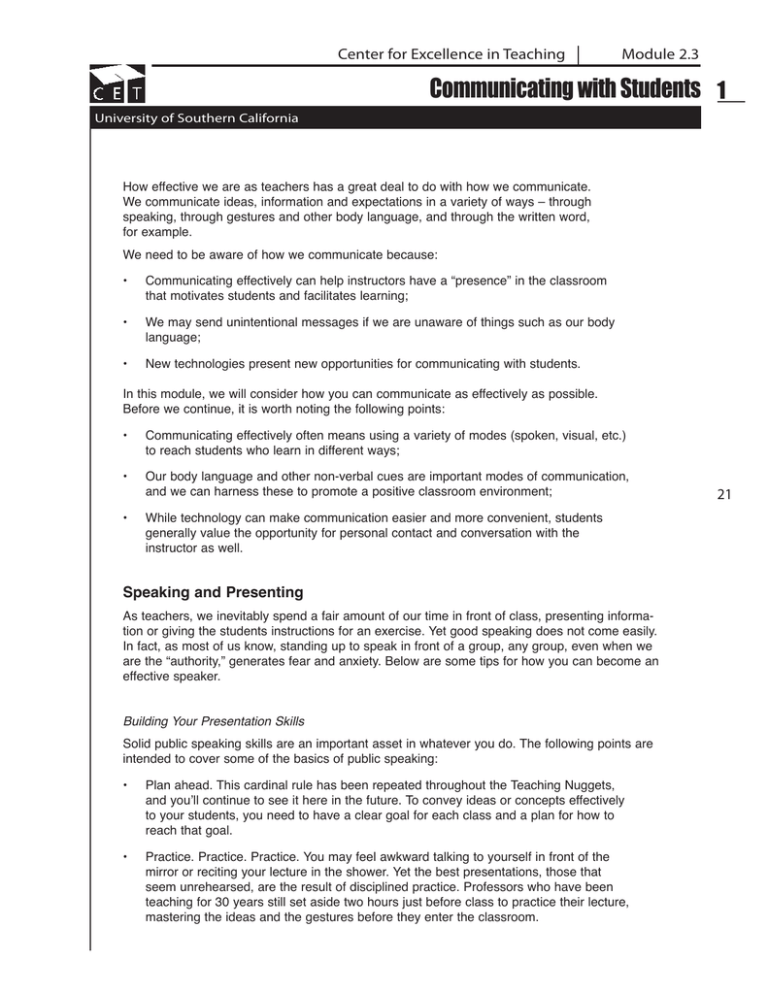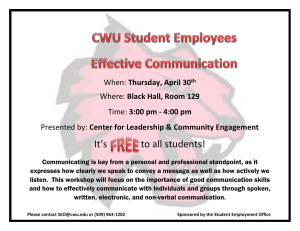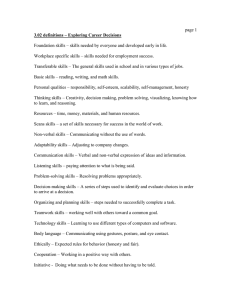Communicating with Students - USC Center for Excellence in
advertisement

Center for Excellence in Teaching Module 2.3 Communicating with Students 1 University of Southern California How effective we are as teachers has a great deal to do with how we communicate. We communicate ideas, information and expectations in a variety of ways – through speaking, through gestures and other body language, and through the written word, for example. We need to be aware of how we communicate because: • Communicating effectively can help instructors have a “presence” in the classroom that motivates students and facilitates learning; • We may send unintentional messages if we are unaware of things such as our body language; • New technologies present new opportunities for communicating with students. In this module, we will consider how you can communicate as effectively as possible. Before we continue, it is worth noting the following points: • Communicating effectively often means using a variety of modes (spoken, visual, etc.) to reach students who learn in different ways; • Our body language and other non-verbal cues are important modes of communication, and we can harness these to promote a positive classroom environment; • While technology can make communication easier and more convenient, students generally value the opportunity for personal contact and conversation with the instructor as well. Speaking and Presenting As teachers, we inevitably spend a fair amount of our time in front of class, presenting information or giving the students instructions for an exercise. Yet good speaking does not come easily. In fact, as most of us know, standing up to speak in front of a group, any group, even when we are the “authority,” generates fear and anxiety. Below are some tips for how you can become an effective speaker. Building Your Presentation Skills Solid public speaking skills are an important asset in whatever you do. The following points are intended to cover some of the basics of public speaking: • Plan ahead. This cardinal rule has been repeated throughout the Teaching Nuggets, and you’ll continue to see it here in the future. To convey ideas or concepts effectively to your students, you need to have a clear goal for each class and a plan for how to reach that goal. • Practice. Practice. Practice. You may feel awkward talking to yourself in front of the mirror or reciting your lecture in the shower. Yet the best presentations, those that seem unrehearsed, are the result of disciplined practice. Professors who have been teaching for 30 years still set aside two hours just before class to practice their lecture, mastering the ideas and the gestures before they enter the classroom. 21 Module 2.3 2 Communicating with Students • Observe and talk with teachers you respect. Typically, we learn to teach by watching those around us. We can make sure this is a positive fact by seeking out the teachers whose skills we admire. Watch carefully the instructors you regard as exemplary. What do they do that makes them so good? Seek them out and speak with them about how they prepare and the techniques that work best for them. • Be observed or tape yourself. Feedback is essential to continuous improvement; even seasoned teachers benefit from having a colleague watch them teach and offer feed back. Particularly if you are new, it can be helpful to practice your presentation ahead of time with a trusted friend and get feedback from him or her. As you progress, have them come to your class, or tape yourself and analyze the results later. Engaging Your Audience Having basic presentation skills is one thing; actually engaging your audience in the learning experience is another. However, there are some things you can do to keep your presentation from being a monotonous presentation of facts that does little to promote learning. • Plan mini-lectures rather than lecturing for the full class. The average student has an attention span of ten to twenty minutes (Davis, 1993). If you try to present for longer, you will almost certainly lose some of your students’ attention. Therefore, break up the class. Talk for a bit, then ask students to solve a problem based on the concepts you have presented. Have them work in small groups to discuss an issue. Ask them to respond to a question. Anything you can do to change the pace of the class will help keep their attention. • Use multiple presentation techniques. Students learn in different ways: some need to hear the ideas; others need to see things written on the board; some need to discover concepts and applications while others prefer to be shown and to have the chance to practice. Communicating information in a variety of ways allows you to meet the needs of different learners. • Know your audience. You would not begin a presentation to Nobel Prize-winning economists by teaching them about supply and demand. Likewise, you should know who your students are and what knowledge they have. Anticipate what they already know, what concepts will cause them particular troubles, and what examples will have meaning for them. Understanding your audience will help you get a sense of when you need to prepare multiple, diverse exercises or examples to make sure they understand a concept, and when you can simply state something and move on. • Check-in with your audience from time to time. Take time to see what your students are learning. Even in large courses, the most distinguished teachers continuously obtain feedback from their students by asking questions and leaving space for students to ask questions. This helps to vary the pace of the class and allows you to see what students are struggling with so you can adjust accordingly. • Avoid reading your presentation. The best talks are those that seem to be spontaneous but have been practiced in advance. Reading from your notes or PowerPoint bores the students, and it prevents you from making eye contact with them so that you can gauge their reactions to your words. 22 Module 2.3 Communicating with Students 3 Developing a Classroom Presence Speaking well is only part of effective teaching. How you say something can be more important than what you actually say. Some experts say that in a verbal exchange, the words we use are only seven percent effective, while the tone of our voice is forty-three percent effective and non-verbal cues are fifty percent effective. Regardless of the percentages, the point is an important one: teaching is about more than simply saying the right words – it is about using your entire person to promote learning. Being aware of your motions, gestures and location in a classroom allows you to establish a presence. • Create variations in your voice. Practice changing the tone, pitch, rhythm, loudness and inflections of your voice. Play with using pauses to punctuate points or recapture students’ attention. Whisper or repeat points for emphasis. Experienced speakers use these and other tools to make key points, emphasize ideas, and keep the audience engaged. • Be aware of your body and its language. Do you stay behind a podium throughout the class? Are you always talking with your hands or are they continually stuffed in your pockets? Do you nod, smile and look at students when they are asking a question or making a point? Find ways to use your motions to help accent the message you are trying to convey. For instance, use your hands to highlight important points. Lean toward the students to emphasize an idea. 23 • Use the physical space of the classroom. Think of the classroom as a stage. While you are not putting on a show, you do wish to have a presence, and actors know how to use a stage to create this presence. Moving around the classroom can convey energy and enthusiasm on your part – and it brings you into contact with all parts of the room. It can also help keep students’ attention and even quiet students who are talking or restless. Be careful, however, since too much movement can be annoying. • Keep a sense of humor. We are not talking about using jokes here – some instructors can do this quite well, and others simply find it is not for them. In this case, we mean you should keep your ability to laugh. Funny things happen in our classrooms, intentionally or not. Try to keep your ability to laugh at yourself and the situation, though not at your students. This kind of relaxed atmosphere is conducive to learning. Using Technology to Communicate Technology provides opportunities to expand your interaction with students. As with any instructional choice, each option has trade-offs that you will need to consider in light of your goals and the needs of the class. Before you decide to use technology, you should ask yourself a simple question: If I use this technology, will it improve the quality of student learning? Use e-mail to interact with students. E-mail is among the most basic of technologies used to communicate with students, and it has at least two benefits: • Students may find it helpful to write carefully and think-through a question rather than ask you directly in class or office hours – and they can do so at any time of day or night. • Written communications with students provide you with a record of interactions, something that can be useful if you are having problems with students. Module 2.3 4 Communicating with Students Listservs are a useful forum for large-scale communication. Listservs are simply a compilation of all students’ e-mail addresses grouped under one address. When a message is sent to that one address, it goes to all students in the class. These can be useful when: • You want students to be able to interact with one another as a group, outside of class. Students can post messages for all to see, debate topics, explore ideas or ask questions. Some instructors require students to post one or two “substantive” messages a week. You need to remind your students of upcoming deadlines, changes in class location, or any special requests you have of them. • Frequently asked questions arise. You can pose the most common questions (based on your experience) and write responses to them – reaching all students in the process. Students can discuss these, raising other questions to clarify the ideas (Laurillard, 1999). Electronic Bulletin Boards and Discussion Groups. These tools are essentially more advanced listservs. They come as part of course management programs such as Blackboard, which are used by USC, and allow for on-going discussions on various topics, “threaded” (or organized) by theme. The benefits include: 24 • You and the students are able to follow discussions on various topics more easily because the conversations are organized by theme – something a listserv does not do. • Students may be encouraged to participate in discussions on-line because they can choose those areas that are most interesting to them or most helpful to their learning. Of course, technology does not address all communication needs. Students value opportunities to have personal interactions with their teachers. And to be an effective teacher, you must be skilled at communicating in many different ways. However, when used properly, technology can augment what you do in the classroom to enhance communication. Concluding Remarks Experiment with pauses, with the tone of your voice, with moving about the classroom. Create a range of methods for students to contact you. Even the most experienced teachers are always tinkering with how they communicate. They are always learning and changing because their students are always changing. By understanding this important fact, and having a commitment to continual improvement, you will go a long way to becoming an effective teacher. Sources Center for Excellence in Teaching. (1999). Teaching Nuggets. Los Angeles: University of Southern California. Davis, Barbara Gross. (1993). Tools for Teaching. San Francisco: Jossey-Bass. Laurillard, Diane. (1999). Using Communications and Information Technology Effectively. In J. Wilbert McKeachie, Teaching Tips: Strategies, Research and Theory for College and University Teachers (10th ed.) (pp. 183-200). Boston: Houghton Mifflin Company. UCLA Office of Instructional Development. (1997). The TA Handbook 1997-98. Los Angeles: University of California.



